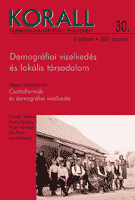Család és házasodás a 18–19. századi Magyarországon. Pest-Pilis-Solt-(Kiskun) megye,
1774–1900
Family and Marriage in Eighteenth and Nineteenth-Century Hungary: Pest-Pilis-Solt-(Kiskun) County, 1774–1900
Author(s): Péter ŐriSubject(s): History
Published by: KORALL Társadalomtörténeti Egyesület
Summary/Abstract: This study addresses the fundamental questions of the modes of household formation (size and structure of households) and the demography of marriage (age at first marriage, proportion of the non-married) in the mixed-ethnicity historical county of Pest-Pilis-Solt-Kiskun, in two time frames (in the 1770–80s and the end of the nineteenth century). The parts of the analysis concerning the eighteenth century are based on settlement-level data in the soul-conscriptions (Conscriptio Animarum) of Pest county (1774–1783) and the census of Joseph II (1785). The section on the nineteenth century is based on data ranked by settlements in the 1890 population census. The data of the Joseph II cadastral register (1789), as well as the confessional, ethnic and vocational data of the population census of 1900 are used as reference variables. Published parish register data of the settlements of the county are used to analyse the intensity of the number of marriages. Our aim is to distinguish between basic types of household formation and marriages in both periods in a county, which can be considered a representative sample in various aspects (varied ethnicity, religion and geographical settlement types). Groups of settlements were formed by means of multi-variable mathematical-statistical analysis (cluster analysis) for both periods on the basis of the available settlement-level census data and the resulting variables. These groups are considered as the basic types of household formation and marriage patterns. Our research question is whether there are discernible patterns of marriages and household structure in the period and geographical region in eighteenth- and nineteenth-century Pest county. Our results suggest that the simplified dichotomous model of European marriage pattern is not acceptable. On one hand, this county is home to both ‘Eastern’ and ‘Western’ models of marriage and houshold structure. On the other hand, there was a number of transitory types between the two models, the ethnocultural interpretation of which is not fully satisfactory either. While the eighteenth- and nineteenth-century migration does mix ‘Eastern’ and ‘Western’ ethnicities, and their demographic behaviour is often rather diff erent, different ethnic groups can behave similarly too. In addition, marriage patterns were significantly infl uenced by other factors, such as settlement types, religion, migration, and the industrialisation and urbanisation processes of the second half of the nineteenth-century. Moreover, marriage is only one element of demographic behaviour. The marriage types discussed here are likely to have been part of various rational demographic strategies.
Journal: Korall - Társadalomtörténeti folyóirat
- Issue Year: 2007
- Issue No: 30
- Page Range: 61-98
- Page Count: 38
- Language: Hungarian

